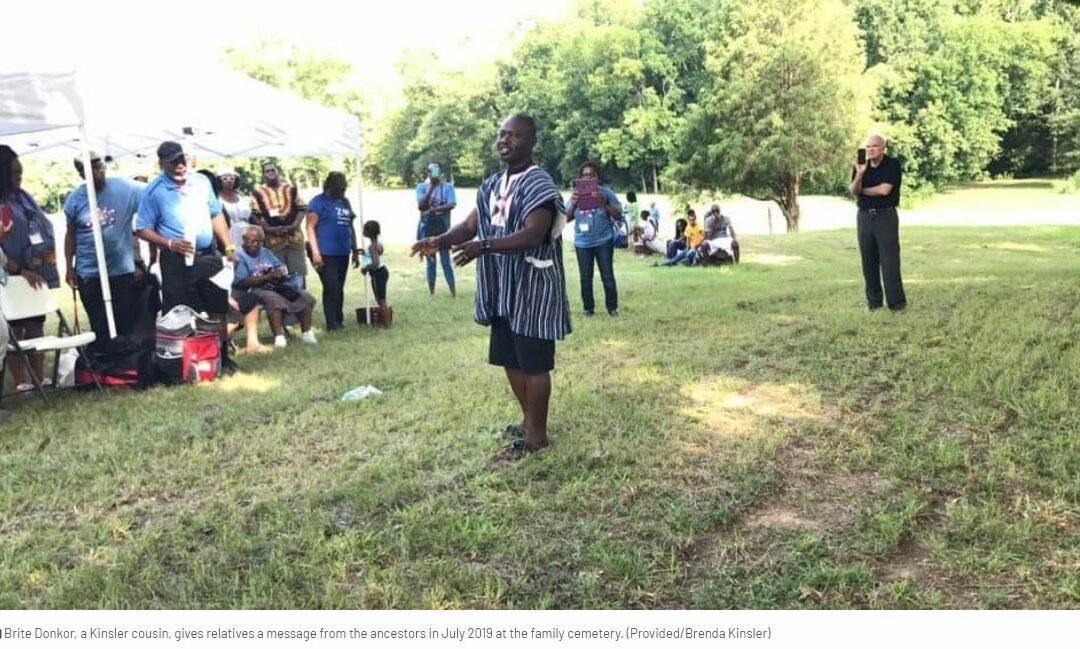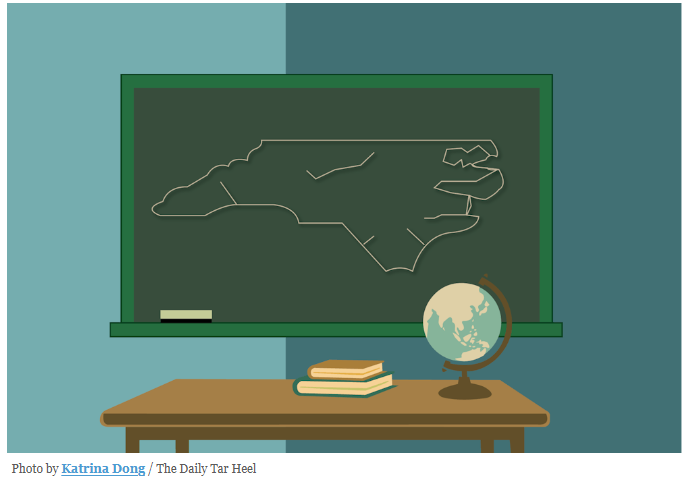SOUTH CAROLINA: Family of Enslavers and Enslaved Reunite at Historic Cemetery
BLYTHEWOOD, S.C. — When Brenda Kinsler’s son was around 10 years old, he came home from school with questions about his family that she couldn’t answer.
“Mom, who are we?” Kinsler, who lives in Washington, D.C., recalled him asking. “Where are we from? Who’s famous in our family?”
Kinsler told him what she could about her family, and about his dad’s side of the family, but the questions brought back ones she asked herself over the years. Curious, Kinsler started searching online.
This was around 2000, so not much was available. But she found herself on a message board, where a man named Charlie Smith in Charleston had asked for some background on his great-great-great grandfather, John Herman Kinsler.
Recognizing the last name as her own — and knowing from past research that her ancestors had once lived in South Carolina — Brenda Kinsler responded. She told Smith that she had relatives in Florida, though she wasn’t sure how they got there. Smith was shocked: He didn’t know his family’s connections stretched that far south.
The two started to exchange family histories. John Herman Kinsler’s family had enslaved Brenda Kinsler’s relatives.
Smith, who is white, and Kinsler, who is Black, are “almost certainly” distant cousins. From what they can determine, their family lines likely branch off seven generations back, Smith said.

During the nearly 25 years since they first started talking, Kinsler and Smith have worked to create a log of the family’s history, tracking down relatives they never knew they had.
This year’s family reunion, which will take place Saturday, is set to be the biggest since Kinsler’s family had its first gathering in 1979 in Florida, starting a biennial tradition that later moved to other cities where relatives live.
This weekend, about 150 people are expected to come to Blythewood to see the place where at least 13 Kinslers are buried.
‘Family historians’
Long before they met, Kinsler and Smith had a common interest in genealogy.
Smith made a hobby of tracking down family lines for himself and for friends. Kinsler spent free time in college tracing her family lineage. They each found bits and pieces of their histories, but it wasn’t until they pooled their knowledge that they were able to start putting together a comprehensive story.
The first connection the two made was with John Herman Kinsler, who died in 1902.
Kinsler, Smith’s third-great grandfather, was a political force in the state during the mid-to-late 1800s. He served as a member of the state House of Representatives, signed the state’s Declaration of Secession in 1860 and fought as a lieutenant colonel in the Civil War.
In 1877, he returned to the Statehouse as a state senator, replacing Black Sen. William Beverly Nash. A former slave who became a wealthy businessman after the Civil War, Nash was part of South Carolina’s majority-Black Legislature during Reconstruction. The 1876 election brought the end of federal oversight and the often-violent rollback of rights extended to newly freed slaves in the state’s 1868 constitution.
Before the war, John Herman Kinsler owned 38 slaves, Brenda Kinsler said.
Little is known about them, since few records were kept about enslaved people. But, knowing Kinslers lived in Florida, Smith and Brenda Kinsler were able to figure out that the old Kinslers owned property there, where they took some slaves.
That is not a legacy in which Smith takes pride. But it’s not one he shies away from, either. Enslavement is part of the family’s history that both branches say needs to be acknowledged.
“We’ve done a lot of stuff together, which is great, because it’s a story that should be told as one story,” Smith said.
As Kinsler and Smith worked to create a family tree, including slave owners and enslaved people, relatives dubbed them the family historians. They spent decades pouring through any old documents they could find to track down historical connections.
The family was luckier than many descendants of slaves, because the white Kinslers for the most part kept families together, making it easier to track them down, said Cynthia Parker White, another Kinsler cousin, who is Black.
Now, in the era of businesses such as Ancestry and 23andMe, which use DNA to find family lines, more distant relatives than ever have been joining the family. After being freed, some families with the Kinsler last name settled in Florida, while others remained in South Carolina. Over the years, people moved, and parts of the family are now scattered across the country.
Some relatives want to be more involved than others, but the Kinslers welcome anyone with any connection to the bloodline, Kinsler said.
That’s how attendees of the biennial family reunion quickly doubled. About 65 people attended each of the last two reunions. About 150 relatives are expected to make the trip to Blythewood this weekend. There are more family members who’ve been in touch who just can’t make it, she said.
The family cemetery
Around 2004, Kinsler came to visit Smith in Charleston for the first time, her two daughters accompanying her. Before Kinsler returned home, she wanted to do one thing: Find a graveyard where her ancestors had been buried.
A cemetery like that wouldn’t be on most maps, Smith told her.
They both knew finding marked graves for enslaved people would be difficult, but Kinsler was determined to try. The white Kinslers at one point owned land in Blythewood, near Columbia, so the two started there.
A farmhouse on Kinsler Road seemed like a good bet, so Smith and Kinsler knocked on the door to ask if the owners had heard anything about a cemetery. The man who answered told them, “I’ve been waiting for you,” Kinsler recalled.
Dick and Mary Burnside, who own the property, led Smith and Kinsler to a piece of land dotted with grave markers. The couple had been caring for it for years, thinking one day relatives would come looking for it, they told Smith and Kinsler.

When Kinsler stepped into the cemetery, she felt an instant connection.
“It was this joy and being overwhelmed and all excited,” Kinsler said. “It was a feeling that I’d never had before.”
The next year, she returned with a cousin and his wife, and they did a modified West African libation ceremony.
They poured wine into the ground and spoke about what they knew about the people buried there, who they knew were taken from that part of the African continent, as a way of connecting with their ancestors and showing their respect, Kinsler said.
The first time White, another Kinsler cousin, walked on the cemetery, all the hair on her body stood up. Talking to other relatives after their visit to the cemetery in 2017, when the reunion was held in Columbia, many said they felt the same thing, White said.
“There was this connection,” White said. “It was like our ancestors were welcoming us there, and there was this feeling of peace that settled over that whole area.”
After the reunion in 2017 — the first attended by Smith — White and Kinsler got to talking about their family history and the research they had done.
“It’s good to have it, but if we don’t put it in a format that it becomes more permanent, then we could lose it,” White recalls telling Kinsler.
So, White compiled Kinsler’s research on their side of the family into a self-published book, called “From Whence We Came: A History of the African American Kinslers.” She asked Smith to write the foreword.
University of South Carolina researchers are working to study the cemetery and preserve it from potential development. The family has come to the spot twice, in 2017 and 2019, to do libation ceremonies and talk about what they know of the people buried on that plot. They plan to do the same this year, Smith and Kinsler said.
A history of slavery
The Kinsler family has a long legacy of educators. Kinsler and Smith uphold that, doing virtual school visits to talk about identity and how assumptions about people can often be wrong.
For instance, they tell elementary school classes, most people would not assume Smith and Kinsler were related, but they likely are.
During one visit, after they had explained the family history, a boy around 8 years old spoke up to say: “‘I don’t know that if I met a white man whose family had enslaved my family I could even bring myself to speak to him,’” Smith said.
“That hit the nail on the head,” Smith said. “That’s exactly why you have to have these conversations, because we have to get beyond them.
“They’re not taboo,” he added. “It’s just history.”
Kinsler and Smith often hear similar sentiments when telling people about their connection. Often, people are skeptical based on the history connecting the families. Those people tend to be surprised to see that reunions are full of hugs and laughter, Smith said.
“The folks who thought it might be more like a sociology experiment are sometimes a little caught off guard,” Smith said.
For recently connected family members, that piece of history “can be a lot for people to digest,” Kinsler said.
“We understand that,” Kinsler said. “But we’re patient. It’ll come.”
Smith and Kinsler are family, no matter what history they share, they said.
“As a family, we can’t do anything about what has happened, but we can come together now,” Kinsler said. “We can have that respect for each other and that love for each other.”
–scdailygazette.com



